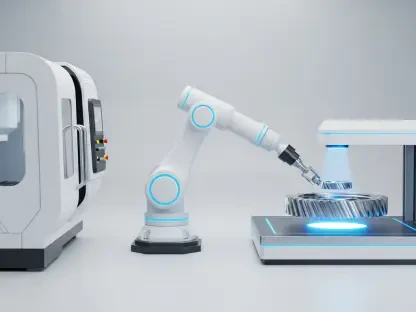The emergence of Industry 4.0 has revolutionized the manufacturing landscape, ushering in a new era of digital integration and automation. This convergent wave of technological advancements necessitates a pivotal shift in supply chain management strategies, prompting a reevaluation of the very concept of redundancy within these modernized industrial frameworks.
Reassessing JIT and Lean Strategies in Industry 4.0
As we advance deeper into the digital age, the application of conventional lean and Just-in-Time (JIT) methodologies is being critically reassessed. The infusion of cyber-physical systems in manufacturing has indeed optimized efficiency but has simultaneously heightened the susceptibility of supply chains to various disruptors.
The Challenges with Just-in-Time Methodologies
Traditionally, JIT strategies have minimized inventory costs and reduced waste, driving companies to streamline their production for peak efficiency. However, the statistic that supply chain disruptions now occur roughly every 3.7 years suggests a grim outlook for the lean approach. These interruptions often have immediate and severe repercussions, underlining the need for a more robust system of checks and balances to maintain operational integrity. The strategic shift toward redundancy counters this frailty, advocating for a buffer to cushion the inevitable shocks and safeguard the continuity of production.
Taiwan’s Semiconductor Monopoly as a Case Study
Taiwan’s indomitable stance in semiconductor manufacturing serves as a stark example of the dangers inherent in geographical production concentration. Boasting a near-monopoly in advanced semiconductor production, any disruption to Taiwan’s output—be it natural disaster, political turmoil, or an energy crunch—translates into worldwide implications. The semiconductor situation sharply displays the need to recalibrate global supply chains towards diversified procurement and increased redundancy to mitigate such concentrated risks.
The Vulnerabilities of Digital Integration
Industry 4.0 may be the harbinger of unprecedented industrial prowess, but the heavy reliance on technology also invites vulnerabilities that must be acknowledged and protected against to ensure uninterrupted operations.
Network Failures and Power Outages
Hiccups such as power failures or network downtimes, though common, bear the potential to halt the digital heartbeat of Industry 4.0-enabled factories. These infrastructural elements are, now more than ever, critical to the seamless execution of operations. Redundant systems, designed to kick in during these failures, can preserve continuity, propelling manufacturing entities to remain operational even when primary systems falter. This level of readiness is paramount to staying resilient in the unpredictable landscape of modern manufacturing.
Escalating Cybersecurity Risks
As manufacturers intertwine their operations with the Internet of Things (IoT) and data analytics, the specter of cyberattacks looms large. These modern-day threats can cripple interconnected systems, causing significant disruptions that extend far beyond a singular entity. It is thus vital to establish and maintain rigorous cybersecurity measures, including monitoring, encryption, and backup solutions—a multifaceted shield against the eventuality of digital intrusions.
Strategies for Robust Redundancy
To combat the vulnerabilities elucidated priorly, a strategic approach to implementing robust redundancy within manufacturing must be pursued. Such strategies should directly confront the susceptibilities of the digitally integrated supply chain.
Implementing Redundant Hardware Solutions
The cornerstone of any redundancy plan is the provision of backup hardware solutions. By equipping facilities with duplicate, critical components and structuring production lines for adaptability, manufacturers can swiftly transition operations to standby systems at the first sign of system failure. This approach ensures a continuous productive presence on the factory floor, diminishing the potency of disruptions to operations and output.
Data and Predictive Maintenance
The deployment of sensors and monitoring devices enables the collection of holistic real-time data, which is indispensable for predictive maintenance. This prescient approach to system care utilizes historical and ongoing data streams to anticipate and preempt potential breakdowns. Through vigilant analysis, vulnerable points within the supply chain are identified, allowing manufacturers to stage preemptive maintenance measures and sustain operational fluency.
Cybersecurity as a Pillar of Redundancy
The digital facets of redundancy, intrinsically tied to cybersecurity, warrant focused attention. The integrity of the system is only as strong as its weakest cyber link, making cybersecurity a foundational element of supply chain resilience.
Network Segregation and Data Encryption
Creating discrete networks for IoT devices and isolating them from core data repositories can minimize the risk of extensive cyber encroachment. Coupled with robust encryption practices, these strategies form a fortress around sensitive information, thereby shielding it from unauthorized access and potential breaches that could otherwise ricochet throughout the supply network.
Regular Updates and Robust Backup Strategies
Within the digital armory of redundancy, nothing is as fundamentally crucial as the routine application of software updates and the establishing of comprehensive backup strategies. Keeping systems current with the latest security patches and maintaining a tight regimen of network surveillance ensures preparedness against the ever-evolving cyber threat landscape, while dedicated backup protocols provide a fail-safe restorative path in the event of data compromise or operational outage.
From Lean to Safety Stock and Procurement Diversification
The lessons from ongoing transitions within industrial spheres beckon a reassessment of lean paradigms, echoing a call for the introduction of buffer stocks and diversified procurement practices.
Building Safety Stocks
The implementation of safety stocks stands as a noteworthy counterbalance to the lean inventory philosophy. Acknowledging the volatility in supply and demand characteristics, adopting an agile methodology that adjusts safety stock levels to match the product’s specific volatility profile is a pragmatic stance. This strategy enables businesses to absorb and rebound from supply chain shocks with minimal operational impact.
Supplier Diversification and Distributed Sourcing
Industry 4.0 has brought a seismic shift to manufacturing, fundamentally transforming it with a synergy of digitalization and automation. This new industrial revolution necessitates that supply chain management practices undergo significant changes to keep pace with the advanced, interconnected industrial environment. As factories and supply networks become smarter and more responsive, the traditional approach to redundancy is being questioned. In the past, having surplus resources or duplicate systems was seen as a safety net against disruptions. However, with real-time data, predictive analytics, and the Internet of Things (IoT), the need for such redundancies is being reexamined. The key challenge lies in creating a supply chain that is both resilient and lean, utilizing smart technologies to forecast and mitigate risks without excessive overcompensation. This balance will define the supply chain strategies of the future, spotlighting the importance of adaptability and strategic innovation in an ever-evolving manufacturing sector.









